Hood for a kitchen with an air duct: how to arrange a hood in the kitchen with and without a duct
The issue of arranging ventilation is relevant among owners of apartments and private households. After all, it is immediately necessary not only to determine the scheme, create a project, but also to implement it by completing installation work. Agree, it would be nice to arrange everything yourself, saving on the call of the master.
But you do not know where to start and how to act? We will try to help - in this article options for installing the hood and their features are considered. So, one of the simplest solutions is an extractor hood for a kitchen with an air duct. If you wish, it is easy to arrange it with your own hands, before starting work, having studied in detail all the nuances given in this material.
Also, the article is supplemented with photo collections of step-by-step assembly, installation and connection of an exhaust device. For a better understanding of the material presented, videos on manufacturing air ducts and connecting hoods are selected.
The content of the article:
Features and rules for choosing a hood
In the kitchen, the hood is not only one of the elements of the ventilation system. Often it is an independent detail of the interior, a certain accent or the final chord of the chosen style solution for a particular room.
In order for it to function perfectly and delight with its impeccable appearance, you have to choose the right option.
Varieties of kitchen designs
A variety of shapes, sizes, additional functions and a significant price range makes it difficult to choose. First of all, it should be understood that the hood is equipment designed to remove exhaust air from the room that contains particles of grease, dust and an unpleasant odor.
For example, when the homeowner fries chops and wants to protect the rest of the family from this overly intrusive smell, he will turn on the exhaust equipment. If the aroma of coffee is in the room, then you can do without it.
Model Specifications
It is important that the hood is designed for such loads and can successfully remove harsh and unpleasant odors in full. This is provided by the purchase. device of the required power.
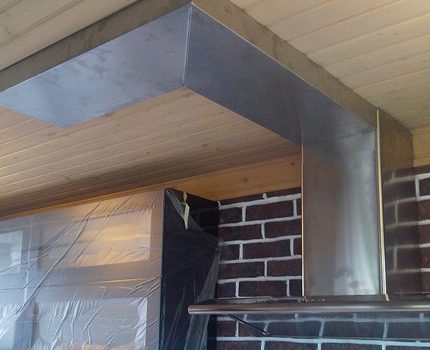
When choosing equipment, it is necessary to carefully study the technical specifications indicated by the manufacturer in the accompanying documentation.
A suitable option is to remove the exhaust air volume, which is 3 times the volume of the kitchen. For example, if the room area is 12 m2, and the ceiling height is 2.7 m, then its volume is 12 * 2.7 = 32.4 m3.
To cope with its main function, the hood must remove at least 32.4 * 3 + 20% = 117 m3. A margin of 20% is needed so that the device does not constantly work at the limit of its forces. Otherwise, such work will quickly disable him.
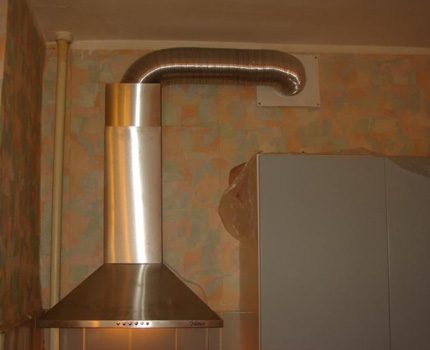
Preferred Mounting Type
By type of installation, all hoods can be divided into:
- recessed;
- open.
The first type of equipment is built-in range hood - has a more modest appearance. They are installed inside cabinets or other kitchen furniture. Inoperative, they are almost invisible.
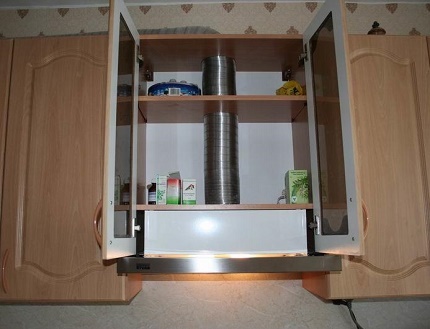
The second type - open hoods - can have the most intricate shapes and sizes. Their cost can be shocking, especially if it is a design model that exists in a single copy.
Cooker hood shape
Depending on the shape of the product, these hoods are distinguished:
- angular;
- island
- wall.
The latter do not require the installation of an air duct with subsequent connection to the ventilation shaft of the house. This is a hood option. without venting.
Their design provides for the presence of several types of filters, among which carbon filter, fatty type filtering device and others, providing local air purification, and not its removal from the room.
All other options for hoods need a ventilation duct.In terms of size, material used and cost of the product, you can always choose the most suitable option, taking into account the wishes and financial capabilities of the owner of the house / apartment.
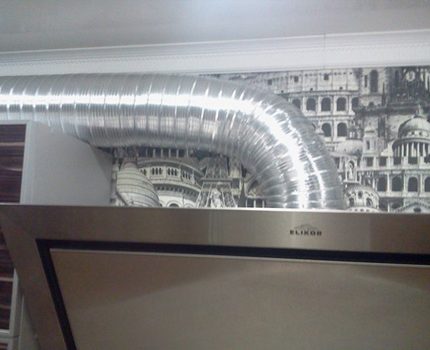
Landmarks and nuances of choice
In order for the hood to be a beautiful and useful part of the kitchen interior, you need to choose a successful model. To do this, you have to choose a product from a manufacturer who has a good reputation.
The price does not have to be high, the main thing is that all the quality documents, instructions for use and warranty are available from the seller. Otherwise, it is better to look at another option.
An ideal hood should perform the following functions:
- to qualitatively remove odors;
- create a minimum of noise;
- look aesthetically pleasing;
- blend harmoniously into the interior.
The main purpose of this element of the ventilation system is to remove exhaust air. No matter how beautiful and perfect its design is, but failure to fulfill its main task makes such an extract a useless trinket. To avoid this, when buying, special attention should be paid to power.
If the hood is correctly installed and connectedthen it is noisy loudly. If, during the installation process, mistakes were made, the wrong parts were selected, and the power of the device itself does not meet the required norm, then you should prepare for a high noise level - 50 decibels or more.
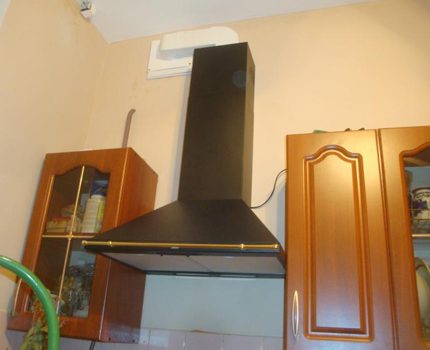
The main problem is to harmoniously fit the purchased hood into the existing kitchen interior. Especially when the ventilation hole is at a considerable distance from its location.
Here comes to the rescue box construction for laying the duct from the hood to the entrance to the ventilation shaft of the house.
It is important to give the duct and hood an aesthetic appearance at the end of installation work. This applies to both purchased equipment and home-made designs.
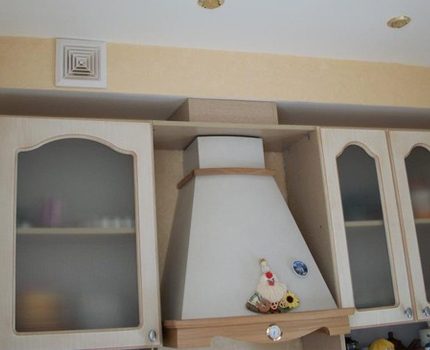
The specifics of equipping a cooker hood
For the kitchen hood, in addition to the equipment itself, additional materials will be required - an air duct and fasteners for it, a duct and fasteners for its installation.
It is advisable to immediately buy other supplies needed for the connection. It is more convenient when all the components will be of the same brand, so that a complete match in color and size is ensured.
Subtleties of choosing and installing ducts
Among the ducts offered in construction stores, you can find the following:
- corrugated polymer;
- aluminum corrugation;
- corrugation made of stainless or galvanized steel;
- plastic round pipe;
- plastic rectangular duct.
The most used for arranging household ventilation - aluminum corrugation and plastic pipes of rectangular and circular cross-section.
This is due to the ease of installation, which even an inexperienced home master can handle.
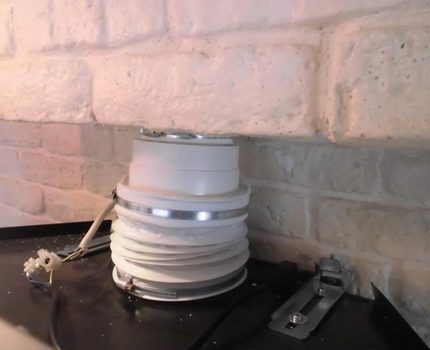
Some inexpensive hood models come with a corrugation made of plastic. To use it or not - it depends on the type and size of the plate over which the exhaust equipment is to be installed.
If the kitchen has a gas stove, then the craftsmen prefer to buy a good metal corrugation from a reliable manufacturer instead of the plastic that comes with the kit.
To equip a domestic ventilation duct, you should choose a quality product.Too delicate and thin foil corrugations can tear from careless handling during installation.
Corrugated metal pipe in some interiors fits harmoniously without the need to come up with options for masking it. Although most often it is necessary to hide it in every possible way, so as not to violate the harmony of the kitchen space.
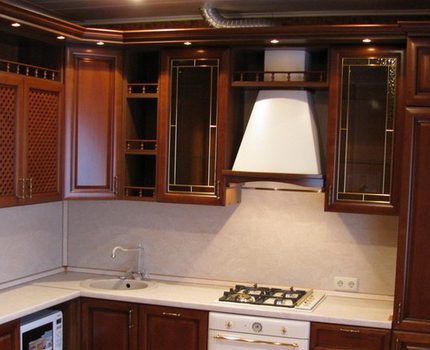
The corrugation is installed simply - it is enough to attach one end to the pipe of the hood itself, and insert the second into the grill of the ventilation shaft.
As fasteners use clamps, aluminum tape, sealant.
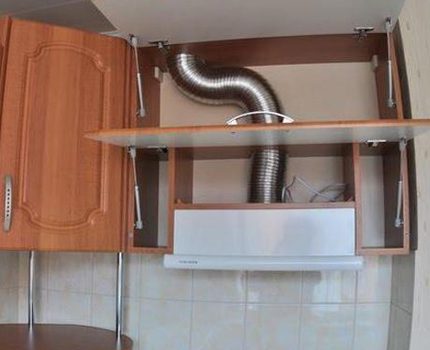
Round and rectangular plastic pipes look more aesthetically pleasing. They do not bend in different directions. Their installation will also not be difficult - all parts are attached to each other, like a designer.
To join, they buy special adapters. It is inconvenient that the turns here will be sharper, and not smooth, as in the case of a corrugated pipe.
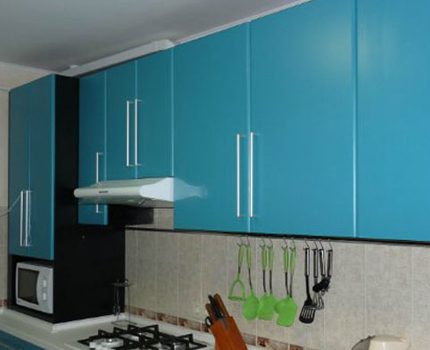
Choose for your kitchen exactly the option that will more harmoniously fit into the interior. If the budget involves the use of a very small amount for the purchase of the duct, then you can buy an inexpensive aluminum corrugation and skillfully disguise it.
It is worth noting that the desired footage of the corrugated pipe is measured in a stretched form. And the right length of the smooth plastic pipe should be accurately measured at home, given that the turns will be clear.
Immediately you need to buy all the adapters for pipes and preferably from the same manufacturer.
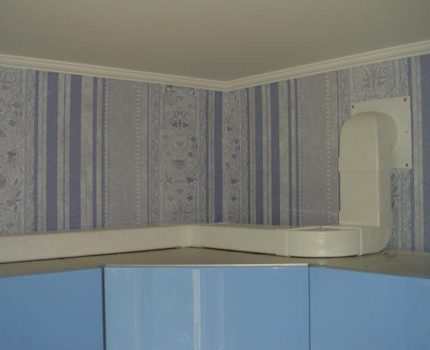
Another important point when buying a ventilation duct is the selection of the correct diameter recommended by the manufacturer of the hood. A smaller or larger pipe will contribute to poor equipment performance. It is also best to purchase all the fasteners of one company.
Equipment mounting options
When the hood and all additional parts are purchased, it remains to put it and connect to ventilation system.
There are 2 options for carrying out this type of work:
- do it yourself;
- hands of a professional.
Each of the options has its pros and cons.
The sequence of works on the construction of a hood with a flexible duct will demonstrate a selection of photos:
If you trust the masters, you will have to pay a decent amount for their services.
And it does not make sense to call a cheap brigade - they can turn out to be bad specialists, capable of spoiling expensive equipment.
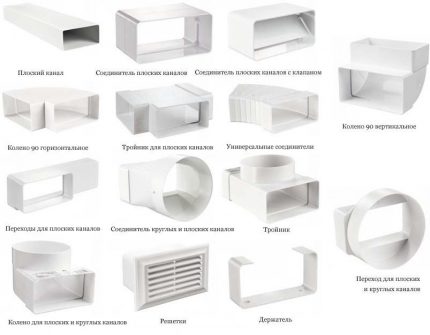
The first option is more reliable if the home foreman has some experience in repair or construction work. When the owner does everything with his own hands, he knows what is delivered and where.
Also, no one will deceive himself - all the work will be done efficiently. Just need to carefully study the instructions so as not to lose the warranty on the hood.
When doing the work on their own, the following are important:
- safety;
- correct connection;
- great appearance.
To ensure the safety of the installed element of the ventilation system, it is necessary to strictly comply with the requirements of the instructions and recommendations of the manufacturer. After all, each model hood has its own characteristics.
The materials used in the manufacture are also different - stainless steel can withstand higher temperatures than plastic.
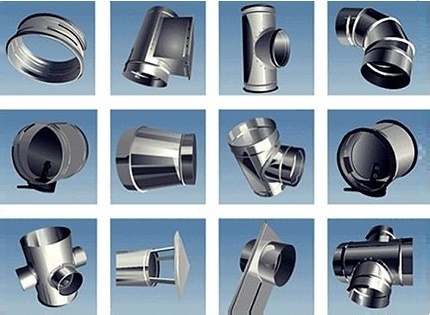
To independently connect a cooker hood to ventilation, you must first attach it. For this, the manufacturer's recommendations set out in the instruction manual are useful.
Each type of hood has its own installation features. For example, for built-in models, you will have to cut a hole in the bottom of the kitchen cabinet, and the dome ones are attached to the wall with the fasteners that come with the kit.
After installing the hood, you have to attach an air duct to it, the second end of which is attached to the entrance to the ventilation shaft of the house. It will not be superfluous to install immediately and check valve.
The duration and complexity of subsequent work depends on the type of duct used to connect the hood in the kitchen to the ventilation system.
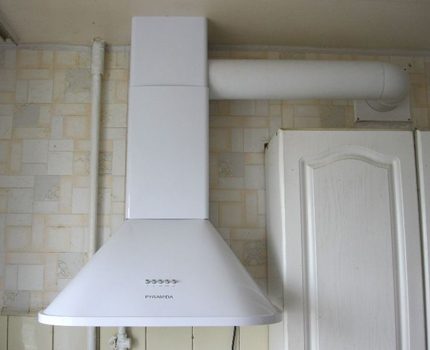
If the selected ventilation duct does not fit the overall style composition, then you have to mask it. For these purposes, special boxes are used.
Such products can not only hide the duct, but also decorate the kitchen space. But their installation may require considerable strength and skills from the master.
Types and nuances of installation of ventilation ducts
To mask individual elements of ventilation equipment, you can purchase a special box. Most often, you need to hide the duct, knocking out of the big picture.
It is for this component of the kitchen ventilation that you can build a box yourself. Which option is appropriate in a particular room is up to its owner only.
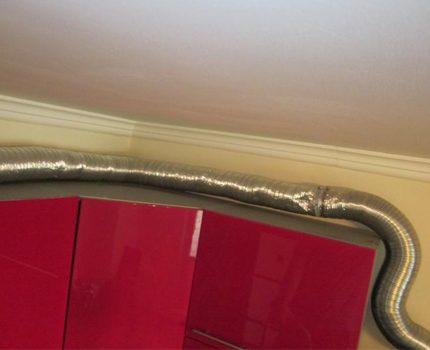
Depending on the material of manufacture, you can buy the following options for boxes:
- plastic;
- aluminum;
- from stainless steel;
- wooden.
Next, we consider the features of each of the announced options.
Features of the use of plastic
Plastic pipes used as an air duct are often called ducts. Due to their clear geometric shape, they do not require the use of any additional material for masking.
Unless in the absence of the desired shade on sale, they can be painted with moisture-proof and heat-resistant paint. Such a move will allow the ventilation duct to become inconspicuous.
Metal fume hoods
Metal boxes are an expensive solution. They are interconnected as well as plastic, using adapters.
But in view of the greater weight, they require more reliable fixation along the path of the ventilation duct.

Wooden box construction
A fume hood made of wood gives a special atmosphere to the room. Such products should be used in wooden houses, where all furniture is simple and made of environmentally friendly materials.
For the apartment, the use of wooden boxes is also acceptable, the main thing is that the style of the kitchen design matches.
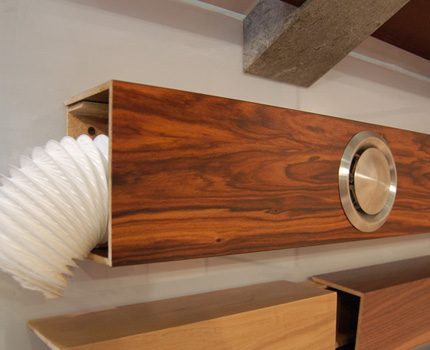
Drywall box manufacturing
Another material used to make the box is drywall. It is used by craftsmen who prefer to make a construction for the ventilation duct with their own hands.
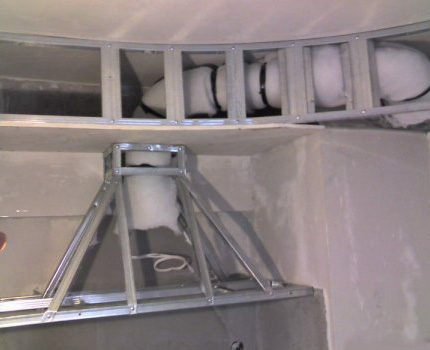
Usually such a box is puttied, primed and painted in a suitable color. At once, at the stage of installation, a backlight is built into it.
This distracts attention, giving the room an unusual look due to a two-level ceiling and additional light sources.
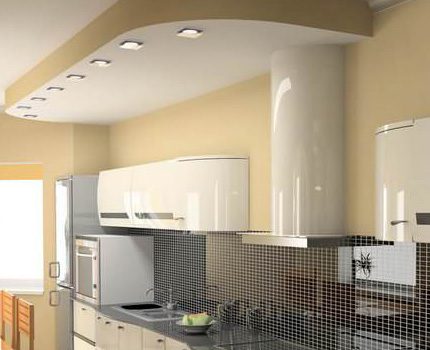
Arrangement of hoods without duct
A kitchen hood with an air duct can be arranged without using a duct.
This happens in such cases:
- the mine is located nearby;
- the use of a false ceiling;
- hood without duct;
- plastic pipes of rectangular / round section.
To mask the hood itself, a kitchen cabinet is sometimes used.
The best location for the hood is under the hole in the ventilation shaft. In this case, the corrugation can be closed with a beautiful hood of the hood.
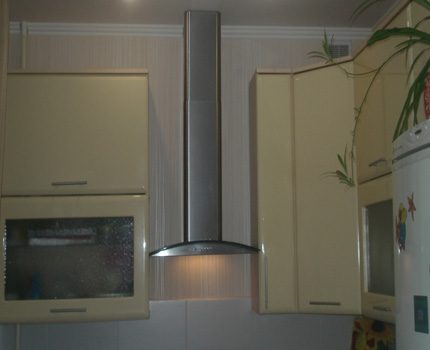
If the kitchen provides for the installation of a false ceiling, then all the designs of the exhaust system will hide well under it. The main thing is to warn the masters who will be engaged in the ceiling about this.
When the hood is installed in the kitchen without a ventilation duct, then there is no need for a duct. In the case of the use of plastic pipes as an air duct with a rectangular or circular cross section, it is quite possible to do without a duct.
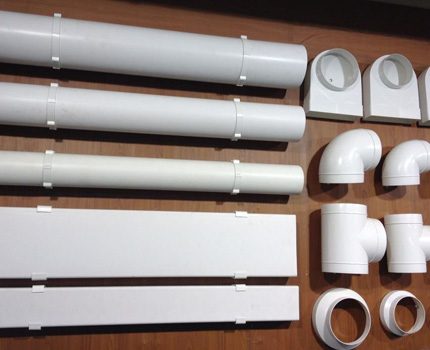
Conclusions and useful video on the topic
A step-by-step video on collecting the duct for a kitchen hood from rectangular plastic pipes with a section of 60x120:
Visual video tutorial on the manufacture of duct ducts simulating a two-level ceiling. For greater efficiency, it is equipped with decorative lighting:
A short video about the features of installing plastic ducts:
Video installation instructions for the hood:
Having studied the features of installing the hood and its connection to the ventilation shaft of the house, you can choose the most suitable option for your kitchen.
In the case when the budget is limited, all installation work of the hood, duct and duct can be done by yourself. You can choose all the components of a kitchen ventilation system in an inexpensive price range.
Have you installed a cooker hood and connected a duct to the ventilation system? Or maybe you have experience in manufacturing the original duct duct? Share your knowledge with beginners in this matter - leave comments on this article.

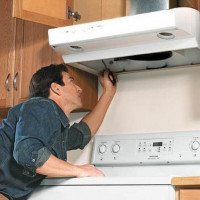 How to install a hood above a gas stove: step-by-step installation instructions
How to install a hood above a gas stove: step-by-step installation instructions  How to hang a hood over a gas stove: step-by-step installation guide
How to hang a hood over a gas stove: step-by-step installation guide 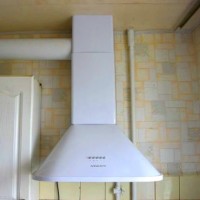 How to install the hood if the gas pipe interferes: briefing on the work
How to install the hood if the gas pipe interferes: briefing on the work  DIY hood installation in the kitchen: detailed step-by-step installation instructions
DIY hood installation in the kitchen: detailed step-by-step installation instructions 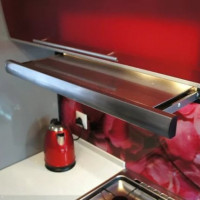 Hood without venting to ventilation: principle of operation, typical schemes and installation rules
Hood without venting to ventilation: principle of operation, typical schemes and installation rules 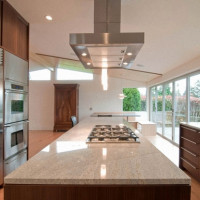 How ventilation is built in the kitchen: rules and diagrams of the hood
How ventilation is built in the kitchen: rules and diagrams of the hood  How much does it cost to connect gas to a private house: the price of organizing gas supply
How much does it cost to connect gas to a private house: the price of organizing gas supply  The best washing machines with dryer: model rating and customer tips
The best washing machines with dryer: model rating and customer tips  What is the color temperature of light and the nuances of choosing the temperature of the lamps to suit your needs
What is the color temperature of light and the nuances of choosing the temperature of the lamps to suit your needs  Replacement of a geyser in an apartment: replacement paperwork + basic norms and requirements
Replacement of a geyser in an apartment: replacement paperwork + basic norms and requirements
If the hood is powerful, then when operating at full power, sound interference is inevitable. Even if the noise is small at first, it will increase over time. It is important to choose the right hood area: it should cover at least 80% of the stove area. The distance between the hood and the electric stove should be between 65-75 cm. For a gas stove, the distance should be 70-85 cm. Do not forget to install a non-return valve in the exhaust duct, otherwise odors from neighbors will run through the ventilation and will inevitably get into your room.
Recently we moved to a new house: a newly commissioned new building on 24 floors. We have already planned how to arrange the hood, looked after the model ... and it turns out that in our house it is supposedly impossible to take the hood to the ventilation duct! It turns out that this is not provided for by the design features, and the management company can even be fined for it! Honestly, I am in a slight shock - how can this be? Is it possible that ventilation shafts in the kitchen were not originally intended for connecting hoods?
Good day, Natalia. You have provided too little input.
I can assume that you have a gas boiler or boiler installed in your kitchen. Most likely the apartments come with autonomous heating. For safety reasons, the ventilation hole must remain open. In the event of a carbon monoxide leak, natural ventilation will remove it from the room.
As one of the options, choose a recirculation hood. Details can be found here. The nuances of the operation of coal hoods in this article.
Of course, ventilation shafts are not designed to connect hoods.
I deliberately refused to carry out a hood with a box in my kitchen. Firstly, this complicates the design, and secondly, such an extract, due to the presence of the ventilation duct in the structure, collects a greater amount of the carcinogen that it draws.
Arrangement of a hood without a duct was easier from the point of view of an engineering solution. I’ll add from myself that, in fact, the best location of the hood is completely unimportant. Whether it is located directly below the hole in the ventilation shaft or is offset relative to it. The modern design of the hood and its ventilation power allow the hood to be installed without rigidly linking its position relative to the position of the mine ventilation opening.